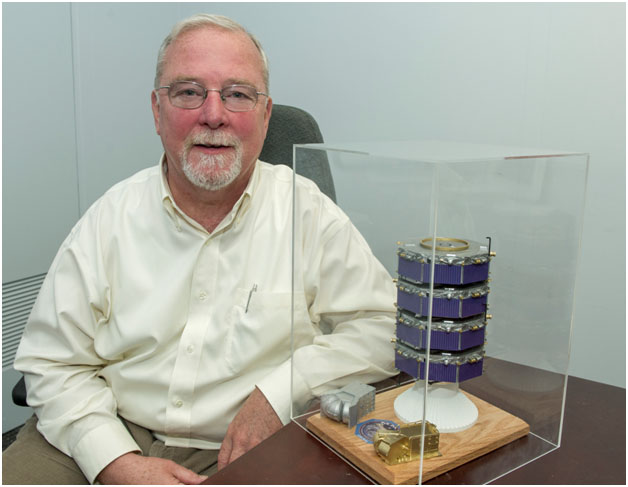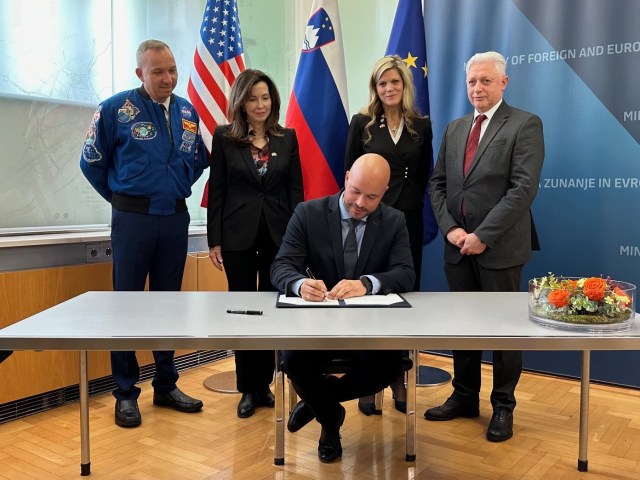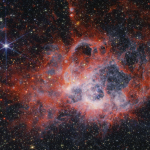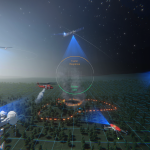
Name: Craig Pollock
Title: Heliophysicist
Formal Job Classification: AST, Fields and Particles
Organization: Code 673, Geospace Physics Laboratory, Heliophysics Division, Science Directorate
Inspired by the Northern Lights as a young man, heliophysicist Craig Pollock has spent his career building instruments to study the charged gas, called plasma, that create the aurora.
What do you do and what is most interesting about your role here at Goddard? How do you help support Goddard’s mission?
I guide the development of instruments, typically for near-Earth space flight. I arrived at Goddard three years ago and have been working primarily on the Fast Plasma Investigation. FPI will fly into Earth’s magnetosphere – the region of near-Earth space defined by Earth’s magnetic fields – and help measure how charged particles are moving through it.
FPI will fly on a mission called Magnetospheric MultiScale, which is scheduled to launch in October 2014. FPI is one of half a dozen instrument types that will fly on MMS. The purpose of MMS is to understand how magnetic reconnection works. Magnetic reconnection involves the annihilation and re-configuration of magnetic fields. This process can also accelerate electrons and ions to great speeds. Magnetic reconnection when the sun’s magnetic fields connect to Earth’s magnetic fields is what opens a door for solar wind energy to enter Earth’s magnetosphere.
How will FPI measure the 3-D plasmas associated with magnetic reconnection?
I build something called top hat electrostatic analyzers, which refers to the style of this kind of instrument for measuring electrons and ions in space. The top of the instrument looks somewhat like an inverted top hat and can be removed. Traditionally, these plasmas have been measured using a single top hat on one spacecraft. We have to be 100 times faster than has ever been done before. We are building 64 top hats for the four MMS spacecraft, resulting in sixteen for each spacecraft. We need so many top hats because the instrument must be able to see everywhere practically all at once, similar to how the eye of a bug works.
What is unprecedented about your project?
Both the time resolution and the sheer volume of hardware we have to build and deliver are unprecedented. Three years ago, a lot of people said it could not be done, but we are close to completion now. We haven’t crossed the goal line yet, but we are pleased with our current status. We just have to keep our eyes on the ball and bring FPI to mission success. This is the most challenging project I’ve ever worked on. We expect great science from FPI, including a rich harvest of plasma measurements from Earth’s magnetospheric reconnection regions.
How big is the FPI team?
The FPI team at Goddard has about 35 people. Marshall also has a small and very effective crew. We also team with Southwest Research Institute in San Antonio, Texas and Space Power Electronics, Inc in Kathleen, Georgia. Internationally, we partner with the Japanese Space Agency in Tokyo, Japan; a Japanese firm named Meisei Electric Co., LTD; and France’s Institut de Recherche en Astrophysique et Planétologie in Toulouse.
Why did you become a heliophysicist?
Before college, I spent four years in the U.S. Air Force stationed at Eielson Air Force Base near Fairbanks, Alaska. During my time in the military, I saw the Northern Lights many times and was absolutely fascinated by them. I still am! At college, I went into physics because I was attracted by the beauty and profundity of mathematical physics. During graduate school, I found a professor who built instruments for sounding rockets that flew over the Northern Lights to find out how they work. I asked him to sign me up. I have spent my entire career working on the same thing, plasma instruments to study space plasmas, which is what creates the Northern Lights.
It turned out that being stationed in Alaska by the Air Force was a fork in the road that determined my entire career and life. So often a decision that seems small and innocuous at the time ends up changing the major course of the rest of your life.
Have you worked at other NASA Centers?
When I finished graduate school, I went to Marshall Space Flight Center as a post-doctoral fellow and stayed for about nine years. I then worked at Southwest Research Institute for 15 years, two of which I was on a special assignment at NASA Headquarters. After that, I came to Goddard.
What changes have you seen in NASA over the past thirty plus years?
When I came into the business in the early 1980s, we were still in the highly exploratory phase of understanding Earth’s space environment. Every time we flew a mission, we learned something new. While that’s still true of today’s missions, the exploratory phase is over. The questions we ask today when we propose a mission are much more targeted and specific. We are now trying to understand the details of the space environment. I have seen the field of heliophysics evolve from toddlerhood to young adulthood. In fact, the name “heliophysics” is less than ten years old. Even today there are only about 3,500 heliophysicists in the world.
How did you remain calm while working in a high-risk profession?
Because we are always pushing the envelope with these instruments, there is always some risk that they won’t work exactly as we’d hoped and designed. I do the best I can to stay focused on the most important objectives, and try to keep ahead of the technical issues. We are conservative regarding risks and only take the risks that we have to take.
I have been very lucky that my wife understood the very high priority I had to place on my work, especially when we had flight hardware being tested. She was always very accommodating and gracious. I thank her often.
What is the one thing you would tell somebody just starting their career at Goddard?
Find a mentor who can guide you very broadly in professional development. A mentor may not need to be in your specific field to help you optimize your professional effectiveness and development. Work closely with that person and be accountable to that person.
Who is the most inspiring person you have worked with at Goddard?
Two extraordinarily inspiring people stand out in my Goddard experience. I am the science lead for FPI. The FPI Instrument Manager, the person who performs the detailed implementation within schedule and budget, is Art Jacques. Art is humble, smart and very low-key. He is also highly effective, absolutely full of integrity and selfless. The project owes much of its success so far to his management skills. He’s a great guy.
The second person who has greatly inspired me is Ulrik Gliese. Ulrik is the technical lead for the Dual Electron Spectrometers, a major component of FPI. Ulrik is probably the single most technically capable person I have ever worked with during my career. His dedication to project success is unsurpassed. Ulrik is almost childlike in his passion for FPI’s success and for technical excellence in general.
What do you enjoy most about working here?
I truly enjoy the opportunity to work with and get to know really superb individuals both in terms of technical capability and dedication to their work. I have felt this way throughout my career.
Is there something surprising about you, your hobbies, interests or activities outside of work that people do not generally know?
My wife and I met and married in college. At the time, our dream was to study and then live in Alaska, but family commitments got in the way. After a family vacation to Alaska in 2003, our eldest son moved to Alaska near Denali National Park and eventually started a tour business. He takes guests out into the wilderness on all-terrain vehicles. At some point, my wife and I hope to join his business. Alaska is the last American wilderness. The landscapes are stupendous. The people are typically frontier people with a very independent frame of mind. They expect others to be independent and do not suffer fools gladly, but are willing to help out in an emergency.
Have you spent Christmas in Alaska?
Yes, for Christmas 2007, my family and I went to Eight Mile Cabin on Eight Mile Lake near Denali National Park. The cabin had no electricity or running water, but did have a wood stove. We came in on an ATV hauling water, food and wood. It was minus 30 degrees during the day and a little colder at night, with the added benefit of a howling wind. There were three or four feet of snow on the ground. Average summertime temperatures are around 70 degrees, but the summers are very short.
Do you have a favorite book or author?
Some of my favorite authors are Irving Stone and James Michener. My favorite Stone book is “Lust for Life,” which is the story of Vincent Van Gogh. My favorite Michener book is, of course, “Alaska.”
By Elizabeth M. Jarrell
NASA’s Goddard Space Flight Center, Greenbelt, Md.

Conversations With Goddard is a collection of Q&A profiles highlighting the breadth and depth of NASA’s Goddard Space Flight Center’s talented and diverse workforce. The Conversations have been published twice a month on average since May 2011. Read past editions on Goddard’s “Our People” webpage.




























